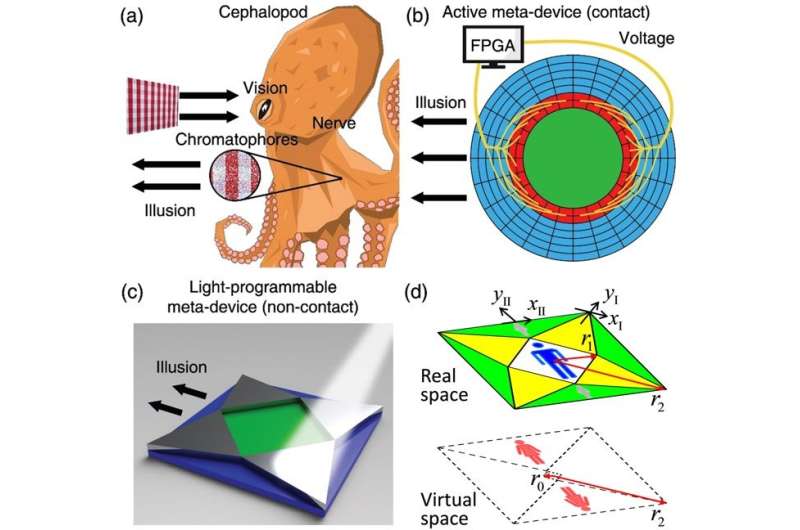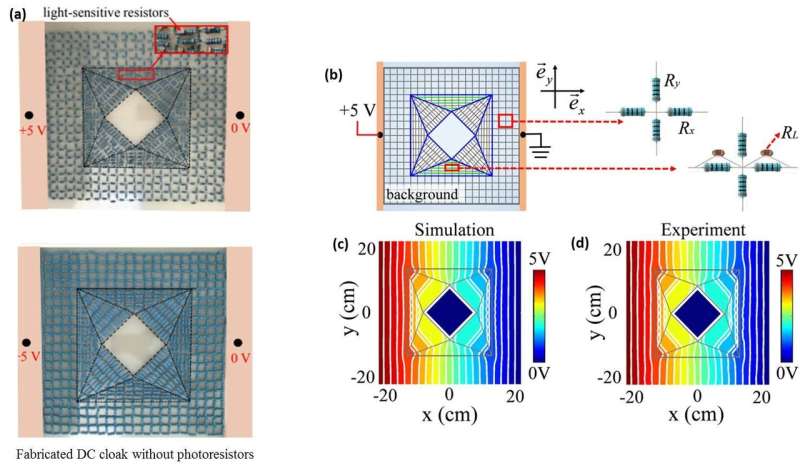Metamaterials to manipulate light: a) the naturally occurring camouflage of a cephalopod that can change skin color and texture in response to an external stimulus and match the external environment, b) an example of a previous Laplacian metadevice connected and controlled by a complex field programmable gate array (FPGA), c) schematic demonstration of a simpler light-programmable illusion metadevice proposed in the study, d) a schematic example showing an illusion created by manipulating the coordinates of light. Credit: Scientific Reports, doi: 10.1038/s41598-018-30612-5
To enable negative refraction and related optical illusions, metamaterials are artificially engineered with unique properties that result from their internal physical structures, rather than their chemical composition. The concept is credited to an experiment conducted by the Soviet scientist Victor Veselago in 1968 to show that negatively refracting materials (as opposed to the typically observed positive refractive index) to create a negative index 'superlens' could be achieved when both electric permittivity (ε) and magnetic permeability (µ) of a material were negative. Thirty-three years after the conceptual proposal, the pioneering work of physicist John Pendry enabled the development of metamaterials as Veselago imagined—a composite material with negative refractive index providing greatly improved resolution.
The new material science paradigm was called "metamaterials," from the Greek word metamorphosis to denote a change of condition. Metamaterial researchers seek to construct new materials from artificial objects with properties beyond the conventional. Decades later, the work continues to attract new interest due to advancements in the field of metamaterials, which include metadevices that are logical extensions of the concept of exploiting functionalities inherent to the metamaterial framework. The field has strikingly progressed in recent years from transformation optics to manipulating electromagnetic properties and inducing transparency to create invisibility cloaks, generating tremendous attention, while moving toward tunable, switchable, nonlinear and sensing functionalities.
In practice, the photonic devices have broad implications with potential to meet increasing demands for faster information transfer by removing the bottleneck of fibre-based optical telecommunication networks, and even enabling military camouflage. The tasks can be accomplished with strong, fast nonlinearities for switching light with light, and improved control of the electromagnetic properties of metamaterials with external stimuli such as electric signals. Now writing in Scientific Reports, Cheng-Wei Qiu and co-workers have developed an experimental method to incorporate multiple functions into one passive Laplacian direct current (DC) metadevice using light illumination without physical contact.
To demonstrate the proof of concept, the team of scientists fabricated a network in which the measurement data agreed exceptionally well with the theoretical predictions and simulation results. The experiment was enabled by an analogy between electrically conducting materials and resistor networks. The researchers sought to design, fabricate and test a metadevice using the circuit theory. The ability to manipulate steady currents by controlling anisotropic conductivities has many potential applications; the focus in the study was to devise light programmable cloaking, full illusion and partial illusion to enable camouflage. The proposed scheme may open new avenues toward non-contact multiphysical control of functions for all kinds of Laplacian fields, including DC magnetic fields and thermal fields.
As a simple demonstration of the proposed theoretical concept, the scientists experimentally realized a metadevice using a resistor network composed of eight resistors, tunable through light illumination, for remote-control without contact. During the experimental verification Han et al., used commercial metal film resistors in parallel to light-dependent resistors to achieve the optically-controlled performance. As a reference they also fabricated a DC cloak, without built-in photoresistors. The experimental setup used a DC power supply with 5 V magnitude as the source and the voltage was measured using a 4.5-digit Multimeter. When the voltage distribution was simulated for the reference DC cloak, the potential distributions outside the cloak restored exactly to those in the homogenous space, to render the central component of the device invisible to the outside observer. Similarly, the measured result for the fabricated reference DC cloak demonstrated excellent cloaking performance in good agreement with its simulation.
Proof-of-concept: a) a photograph of the fabricated light-programmable metadevice combining electrically conducting materials with a resistor network (light-sensitive resistors are seen inset), a reference DC cloak is seen below - fabricated without photoresistors b) schematic illustration of the experimental setup, green lines indicate light-dependent resistors (RL) in parallel to the commercial resistors (R) in the light programmable metadevice, c) the simulated voltage distribution for the reference DC cloak, d) the measured voltage corresponding to (c). Equipotential lines are represented with white color in the panel. Credit: Scientific Reports, doi: 10.1038/s41598-018-30612-5
Similar results were observed for the performance of the proposed light controlled metadevice, showing excellent agreement between the experiment and the simulation. By design, the metadevice was expected to act as an illusion device in bright field light (transform an actual perception into an arbitrarily pre-controlled perception) and become invisible in dark field (experimentally achieved using an opaque material to cover the device). The metadevice was able to switch between cloaking and illusion, within a response time of 0.2 seconds, based on light illumination.
In addition, the authors were able to demonstrate partial illusion when part of the metadevice was exposed to bright field, in which the numerical simulations and measurement data were again in excellent agreement, to demonstrate the controllable and flexible property of the proposed scheme. In the study, the simulations were based on the finite element method (FEM). All resistors were commercial metal film resistors with an accuracy of 1 percent with light sensitive resistors in parallel to realize the proposed light controlled metadevice by the circuit theory. The idea can be extended to other fields governed by Laplace's equation including magnetic and thermal fields.
More information: Tiancheng Han et al. Light-programmable manipulation of DC field in Laplacian Meta-devices, Scientific Reports (2018). DOI: 10.1038/s41598-018-30612-5
Pioneers in metamaterials: John Pendry and Victor Veselago, iopscience.iop.org/article/10. … 978/13/2/020401/meta Allan Boardman, Community Perspective, 2011, J. Optics., IOP Science
An ultrathin invisibility skin cloak for visible light www.ncbi.nlm.nih.gov/pubmed/26383946?dopt=Abstract Ni et al, 2015, Science.
Transformation optics and metamaterials. www.ncbi.nlm.nih.gov/pubmed/20414221?dopt=Abstract Chen et al, 2010, Nature Materials.
All smoke and metamaterials www.nature.com/articles/460579a John Pendry, News & Views, July 2009, Nature.
From metamaterials to metadevices www.nature.com/articles/nmat3431 Zheludev and Kivshar, October 2012, Nature Materials.
Experimental realization of a circuit-based broadband illusion optics analogue www.ncbi.nlm.nih.gov/pubmed/21231465?dopt=Abstract Jiang et al, 2010, Phys. Rev. Lett.
Controlling electromagnetic fields science.sciencemag.org/content/312/5781/1780 Pendry et al, 2006, Science.
Experimental demonstration of a multiphysics cloak: manipulating heat flux and electric current simultaneously journals.aps.org/prl/abstract/ … ysRevLett.113.205501 Ma et al, 2014, Phys. Rev. Lett..
Full control and manipulation of heat signatures: cloaking, camouflage and thermal metamaterials onlinelibrary.wiley.com/doi/ab … .1002/adma.201304448 Han et al, 2014, Adv. Mater.
Experimental realization of a magnetic cloak science.sciencemag.org/content/335/6075/1466 Gömöry et al, 2012, Science.
Experiments on active cloaking and illusion for Laplace equation journals.aps.org/prl/abstract/ … ysRevLett.111.173901 Ma et al, 2013, Phys. Rev. Lett..
DC electric invisibility cloak journals.aps.org/prl/abstract/ … ysRevLett.109.053902 Yang et al, 2012, Phys. Rev. Lett.
Roadmap on transformation optics spiral.imperial.ac.uk:8443/handle/10044/1/57847 McCall M., 2018 Journal of Optics
Journal information: Scientific Reports , Science , Nature Materials , Nature , Physical Review Letters
© 2018 Phys.org
























